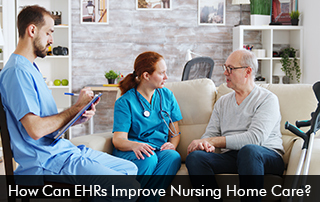Nursing homes, also known as skilled nursing facilities (SNFs) or long-term care facilities, are residential facilities that provide healthcare and accommodation to people who need long-term care due to age, chronic medical conditions, impairments, or other health-related needs. These facilities are an important aspect of the healthcare system, serving a broad population of citizens in the United States.
EMR Software and Nursing Home Care
Many skilled nursing facilities have implemented Electronic Medical Records (EMR) Software and Long-Term Care EMR Software Systems to help support skilled nursing care, medical monitoring, and respite care.
In nursing homes, EHR Software is critical. These software systems aid in the automation and enhancement of different elements of patient care, facility management, and regulatory compliance.
How can EHR Software Systems Benefit Nursing Home Care?
The robust EMR systems technology is a valuable asset that can be leveraged by skilled nursing facilities to provide exceptional and high-quality patient care to the elderly and people suffering from chronic conditions. Some advantages of using electronic health records software in nursing homes include:
Efficient Patient Record Management
Nursing homes can use EHR software to keep detailed digital records of each resident’s health history, including medical conditions, medications, allergies, and treatment plans. This data is easily available to authorized healthcare practitioners, improving patient care and lowering the chance of errors.
Medication Management
Long-Term Care EMR systems can aid in medication management by providing medication administration records (MARs) and features such as automatic reminders for medication administration times. This lowers the likelihood of prescription errors and increases resident safety.
Care Planning
Caregivers at nursing homes can use the Electronic Health Records Software to customize and manage the care plans of every resident. The software is functioned to track progress and any alterations made in patient care over time.
Clinical Documentation and Charting
Electronic Medical Records (EMR) Software makes it easier to document daily care activities, assessments, and other vital information. Nurses can enter data directly into the software system, eliminating the need for paper records and assuring legible, up-to-date, and easily accessible information. Efficient charting tools help to increase work efficiency.
Improved Care Collaboration
The strong interoperability and integration features in the EHR Software facilitate care collaboration between healthcare providers to offer high-quality patient care. Patient data can be exchanged seamlessly between care teams and can be viewed in real-time helping to boost health outcome levels.
Importance of Telehealth EMR Integration in Nursing Homes
For several reasons, telehealth Electronic Medical Records (EMR) systems must be integrated into nursing facilities. Enabling online consultations with providers improves the quality of care by allowing prompt assessments and treatment for residents without requiring in-person visits. This is particularly important for elderly or immobile persons who might not have easy access to transportation or who could experience mobility issues.
Additionally, the integration of telehealth EHR facilitates better patient information sharing and care coordination between on-site staff and remote specialists, which promotes collaborative and informed decision-making. Telemedicine EMR Software also expedites paperwork, guaranteeing that virtual consultations are accurately recorded in the resident’s medical file and foster continuity of care.







